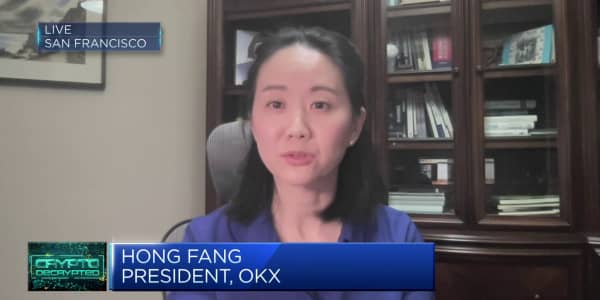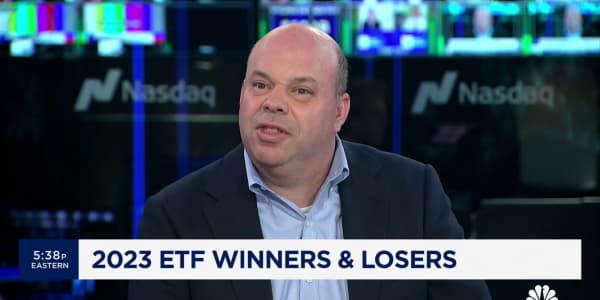The No. 1 rule for long-term individual investors picking funds used to be simple: Look for low fees, also known as low expense ratios. Over time small savings add up to a lot.
"Control what you can control," said Burt Malkiel, whose book, "A Random Walk Down Wall Street," helped found the index investment revolution. But the classic low-fee advice may need an update, say experts in investor behavior.
"Cost has become the new performance metric," said Fran Kinniry, head of portfolio construction in Vanguard's Investment Strategy Group. "The profit-making firms have to make it up somewhere."
Expense ratios for mutual funds have been falling for 20 years, but the "race to the bottom" in ETF fees has picked up speed in the past five. In 2017 the expense ratios of index equity ETFs fell to 0.21 percent, down from 0.34 percent in 2009. Expense ratios of index bond ETFs, down from a recent peak of 0.26 percent in 2013, fell to 0.18 percent in 2017, according to the Investment Company Institute. Fees on other kinds of ETFs, like thematic and country-specific ETFs, are also falling.
Investors are obviously reaping rewards from ultra low fees — but they should also watch out for higher, hidden fees in the same funds, and strategies that lure investors into higher-priced products or into paying more for advice, say experts. There were nearly 2,000 ETFs as of June, according to Vanguard. Low fees used to be a decent shortcut to creating a high-quality portfolio, but in a more confusing marketplace, where fund families are competing on tenths of a percent, sacrificing performance in favor of a lower fee may not make sense, said Todd Rosenbluth, director of ETF Research at CFRA, an independent research firm.
Lowest expense ratio broad US stock funds and ETFs
| Index Fund/ETF | Expense ratio |
|---|---|
| Fidelity Zero Total Market Index Fund | 0.00 percent |
| Schwab Total Stock Market Index Fund | 0.03 percent |
| Schwab Multi Cap Core ETF | 0.03 percent |
| Vanguard Total Stock Market ETF | 0.04 percent |
| iShares Core S&P 500 Equity ETF | 0.04 percent |
Source: Source: Vanguard, Fidelity, Schwab and iShares
Wall Street firms have always marketed on performance and found ways to monkey with those numbers. Now they are marketing on fund cost — which means investors should still be watching their back. "Fund companies are not altruistic," Rosenbluth said.
In other words, fund fees and fund company fees are sort of like a hydra. If you cut off one head, another takes its place, ready to take a bite out of what you keep. Kinniry said he considers aggressive marketing of low fees to be a red flag for investors.
Experts suggest investors follow a handful of rules to help navigate a marketplace where funds are competing on fees.
Beware of funds' back-end and advisory fees. These are extraordinarily difficult for the average investors to watch for. But some funds can say they are low or no-fee on the front end, and yet make up the profits by charging back-end fees or high advisory fees. It might be great to sign up for a no-fee fund (Fidelity introduced no-fee index funds in August).
But if you shift your money to a financial advisor who sells Fidelity funds and charges you 1 percent a year, you've actually raised your costs over what you might have been paying for a fund you bought yourself with an expense ratio of 0.25 percent.
More from ETF Spotlight:
Fidelity's new no-fee index funds bring in $1 billion
Tech stocks look to rebound
Instead of asking about low fees alone, ask what you are paying over 10 years, including all fees. "What is the cost, all in, for 10 years?" said Eric J. Johnson, the Norman Eig professor of business marketing at Columbia University Business School.
Fund companies have been paying close attention to leaps in knowledge about behavioral economics. Some, like the way price-partitioning works, offer powerful advantages to Wall Street marketers.
Airlines have figured this out, said Johnson: Even though you know full well the total you pay for airline tickets will be higher than what you initially see on a price comparison site like Kayak, you still make decisions and compare prices based on what you you see there, and forget to consider taxes and extra costs, which could change which ticket is actually cheapest. If you're picking a fund, you might be tempted to look only at that low-basis point label and never bother to compare the total cost.
Cost has become the new performance metric.Fran Kinniryhead of portfolio construction in Vanguard's Investment Strategy Group
You might also base your decision only on a low expense ratio and forget to consider whether the fund comprises the stocks it ought to. Even in basic emerging markets ETFs, iShares' IEMG includes South Korea; Vanguard's VWO does not, though they have the same fees. Ignoring the underlying makeup of an ETF is like buying your airline ticket based on price but forgetting to check whether the airline has a good safety record.
Watch out for marketing strategies that get you in the door on a low-fee fund and later sell you into high-fee products and services. "There's a sense in which index funds or target-date funds have become the standard," said Johnson. "They are like milk and bread in the grocery store."
"It means the firms are making money other places." In a grocery store, that could mean you walk in for milk or bread but end up buying the overpriced pumpkin spice whipped cream at the checkout counter. In a fund company, you buy an inexpensive fund but end up getting sold on a nifty new retirement strategy, trading on a new hot sector, or trading in general.
Trading could be expensive and end up hurting you in the long run because individual investors have been shown to consistently trade at the wrong times. In late August, Vanguard launched its upgraded brokerage site, with most ETF trading offered free of charge. JPMorgan Chase & Co. offers no fees on as many as 100 trades a year.
That's great, on one hand, because the trades are free. On the other, if it encourages you to trade more, it's probably not. Many firms that have grabbed headlines in the race to the bottom remain in the middling ranks of Morningstar's ranking of fund families with the highest number and largest low- and no-fee funds. The top three are Vanguard, iShares and Dimensional Fund Advisors. BlackRock (which also owns iShares), Fidelity and JPMorgan fall firmly in the middle of the pack.
Focus on the overall risk and return of your portfolio over time, not on fees alone. How much will you keep? Second most important, because you don't want to feel like a chump, is how well your portfolio did compared with one at a similar risk level. Just because an ETF that represents, say, small-cap fast-growth stocks has low fees, doesn't mean it's right for your portfolio — it might have too much risk.
As a point of reference, Kinniry said he expects stocks to return about 6 percent to 8 percent, and a balanced stock and bond portfolio to earn about 5 percent annually, net of fees.
Don't assume the old rules apply. The number of ETFs and index mutual funds has multiplied. Research has shown that low fees on a fund help predict above-average returns (probably because expensive funds are below-average performers). Morningstar reported this in 2015, and the correlation holds true today. But it's less clear that the correlation holds true when the difference in fees is infinitesimal.
In the new world of proliferating ETFs, products that sound the same may no longer be. Consider two gaming-company oriented ETFs. VanEck Vectors launched ESPO, an ETF offered at 55 basis points, last week. It's competing with GAMR, launched by ETFMG with an expense ratio of 82 basis points. The two ETFs are competing, and investors might be tempted to pick based on price. But the two funds have different holdings and thus will have different performance, Rosenbluth said.
Those kinds of complexities in the market will only grow: EY estimated in late 2017 that ETF assets have the potential to hit $7.6 trillion within three years. It's natural to think that you're smarter than the rest of the pack and that you're able to take advantage of what are essentially loss leaders and marketing tactics from fund companies, while being careful to avoid the hidden costs and full-price items at the back of the showroom. Just remember to keep your guard up. Stick with a fund family known overall for low fees and other costs — but even in those cases, be wary.
Don't, Johnson emphasized, overestimate your own diligence. He's a finance professor. "I am the world's most boring investor: I do low-fee index funds," he said. "But if you asked me, Does Vanguard charge me an annual fee? I honestly couldn't tell you."





